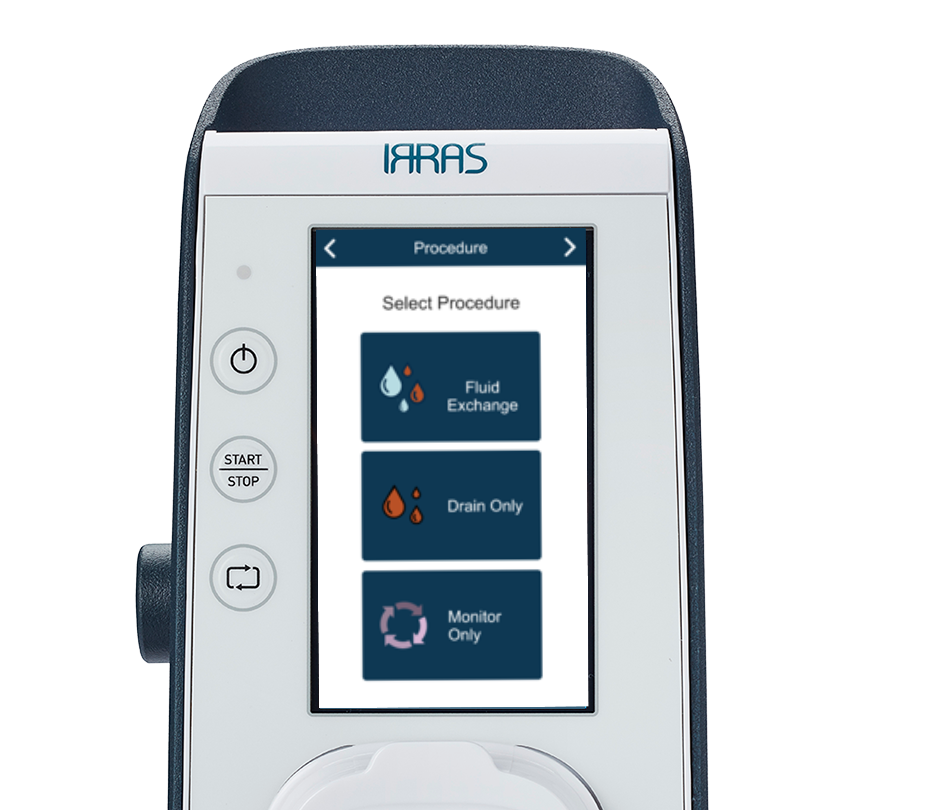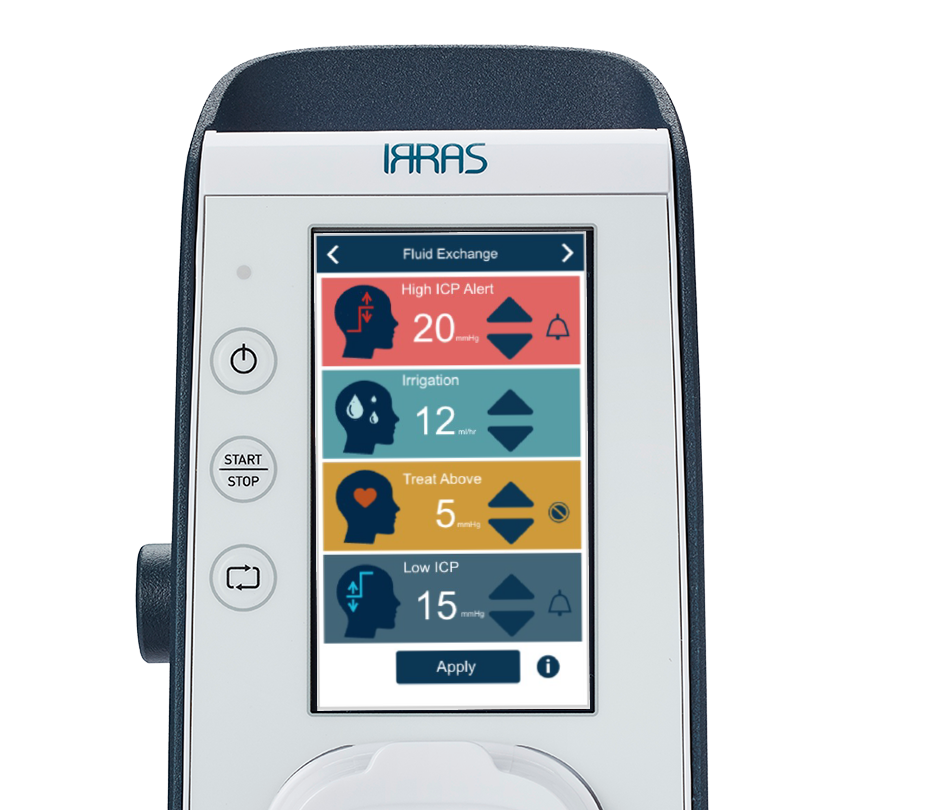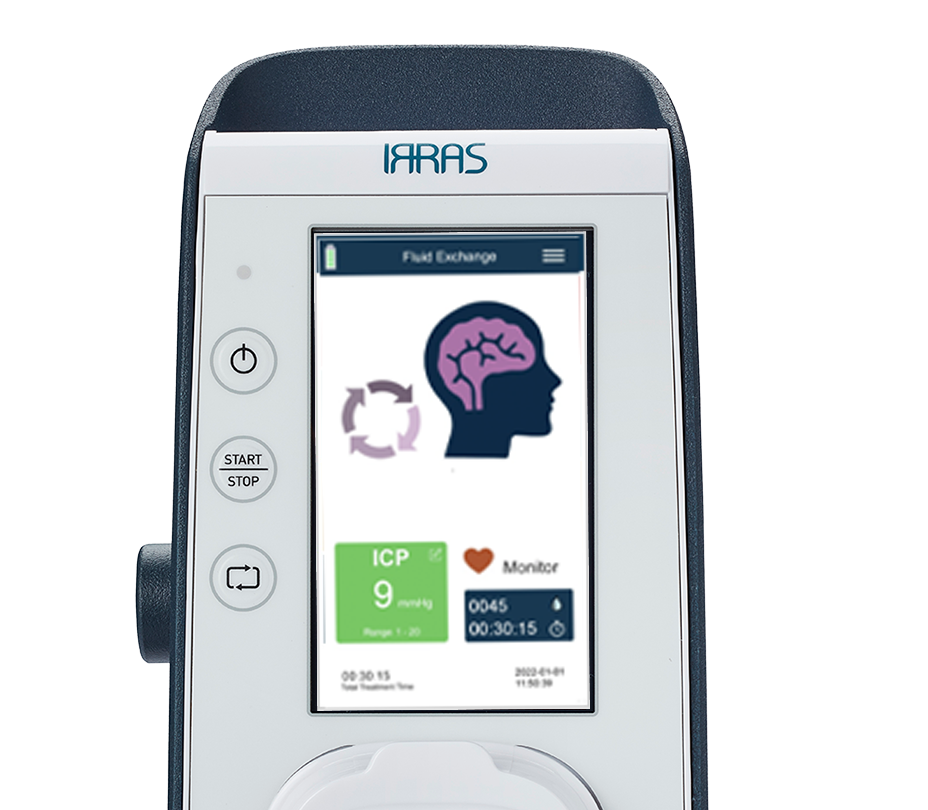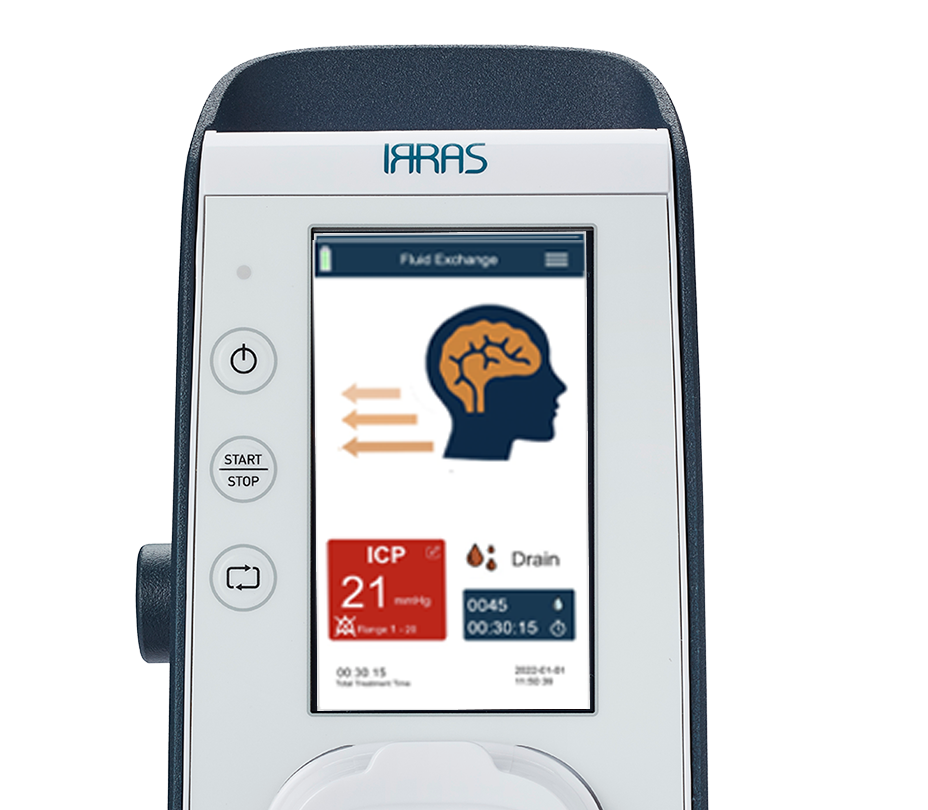The world’s first irrigating intracranial drainage system!
The world’s first irrigating intracranial drainage system!
A fundamental redesign of fluid management technology developed by leading neurosurgeons, the IRRAflow system demonstrates a significant technological step forward compared to other currently available treatment options. IRRAflow’s transformational technology provides a controlled fluid exchange system that allows the neurosurgeon to therapeutically treat intracranial pressure and CSF drainage.

Active Fluid Exchange
A new and needed approach to neurocritical care
Introducing Active Fluid Exchange:
- Controlled, automated irrigation
- Gravity-driven drainage
- Continuous ICP monitoring
- All in one system!
Irrigation. Drainage. ICP Monitoring. All in one!
Active Fluid Exchange is here!
Isn’t it time you tried something new?
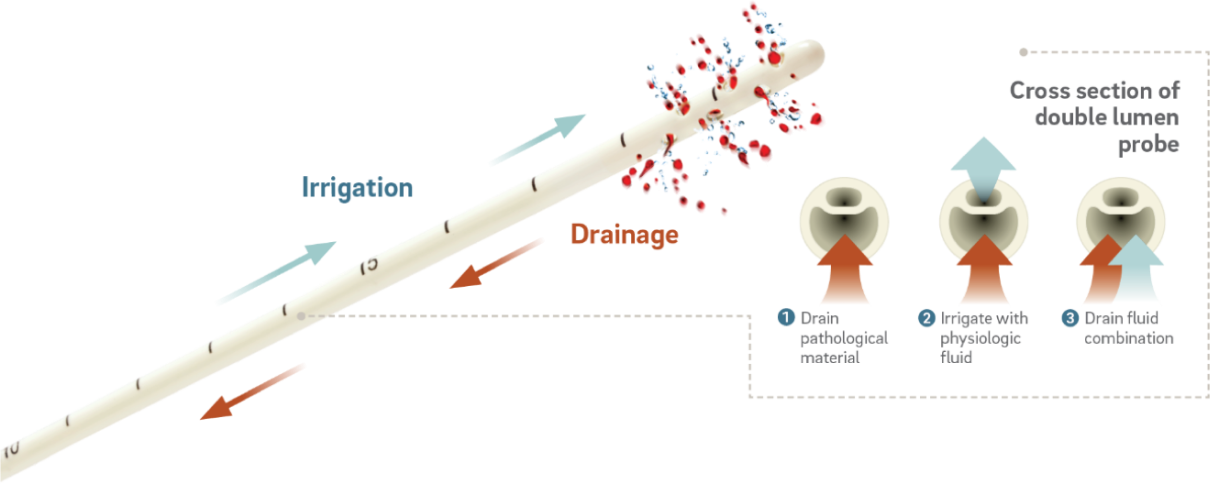
What is Active Fluid Exchange?
The IRRAflow®system was built around the concept of active, controlled fluid exchange. As regularly employed during open surgery, the concept of active fluid exchange is based on the fact that it is faster to wash out any pathological extracellular fluid collection than to expect it to be removed by gravity alone.
Therefore, IRRAflow combines traditional gravity-driven drainage with periodic, controlled irrigation of the catheter tip to exchange any pathological fluid collection with neutral physiological fluids. This fluid movement by design, mechanically cleanses the catheters tip thus potentially facilitating disruption of clot and or bacteria (1,2). Furthermore, this fluid irrigation also helps to keep solid particulate in suspension, making it easier to subsequently drain.
- 1. Rajjoub K, Hess R M, O’Connor T E, et al. (May 22, 2021) Drainage, Irrigation, and Fibrinolytic Therapy (DRIFT) for Adult Intraventricular Hemorrhage Using IRRAflow® Self-Irrigating Catheter. Cureus 13(5): e15167. DOI 10.7759/cureus.15167
- 2. Brandmeir, Nicholas, et.al. Early Experience with Patient Treatment & Drug Delivery with IRRAflow; An Automatically Irrigating and Draining Ventricular Catheter. As presented at The Neurosurgical Society of the Virginias Annual Meeting in January 2022.
IRRAflow System
IRRAflow consists of a control unit and disposables (dual-lumen catheter and tube set) to offer four fully integrated and synchronized functions:

Fluid Exchange System
Fluid exchange system with an irrigating pump and drainage mechanism that interact with a dual-lumen catheter to both supply and evacuate fluid from the body. The system is also synchronized to monitor local body cavity pressure within a preprogrammed range.
Monitoring and Measuring System for Intracranial Pressure
Monitoring and measuring system for intracranial pressure based on a method that uses a fluid column for accuracy and reliability.
Safety Alarms
Safety alarms that can be customized for each patient and are activated when the pressure is higher or lower than the preprogrammed range.
Programmable Periodic Irrigation
Programmable periodic irrigation enables fluid exchange to occur.
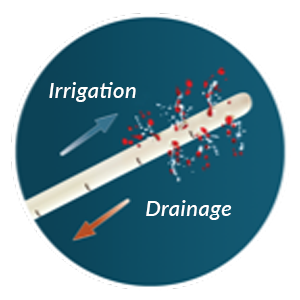
Dual-lumen catheter with active irrigation with CSF drainage

Intelligent Digital Pump enables Automated Irrigation
Dual-Lumen Catheter
With its use of a patented dual-lumen catheter design, IRRAflow allows the user to transition from passive drainage to a therapeutic treatment with active fluid management. Utilizing this dual-lumen design enables periodic flushing of the catheter tip.
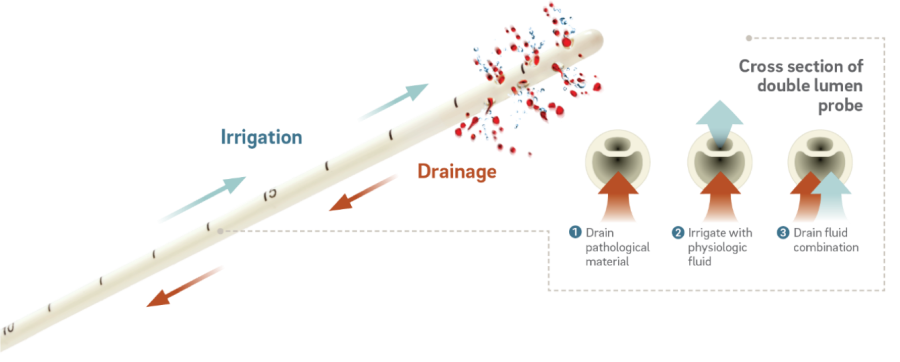
IRRAflow® Advantages
Enhanced Drainage
Current drainage systems, such as external ventricular drains (EVDs), are vital tools in managing a patient’s ICP during neurocritical care situations. By draining excess fluid, an EVD plays a critical role in stabilizing the intracranial pressure (ICP) of these critically ill patients, which can facilitate recovery. Unfortunately, EVDs are generally primitive systems that rely solely on gravity alone, and as a result, they have been plagued by blockages that can lead to inefficient drainage and other complications.
IRRAflow addresses this inefficient drainage by returning control of the drainage process to the clinician. This is accomplished with a therapeutic treatment called active fluid exchange. The IRRAflow patented dual-lumen catheter design facilitates active fluid exchange by enabling irrigation with physiologic fluids and drainage of pathological material. This fluid irrigation also helps to keep solid particulate in suspension, making it easier to subsequently drain. This concept can hereby address the underlying reasons that result in historic shortcomings typically associated with passive drainage alone: catheter blockages and infection.
- 3.Rajjoub K, Hess R M, O’Connor T E, et al. (May 22, 2021) Drainage, Irrigation, and Fibrinolytic Therapy (DRIFT) for Adult Intraventricular Hemorrhage Using IRRAflow® Self-Irrigating Catheter. Cureus 13(5): e15167. DOI 10.7759/cureus.15167
- 4.Brandmeir, Nicholas, et.al. Early Experience with Patient Treatment & Drug Delivery with IRRAflow; An Automatically Irrigating and Draining Ventricular Catheter. As presented at The Neurosurgical Society of the Virginias Annual Meeting in January 2022.

Active Fluid Exchange
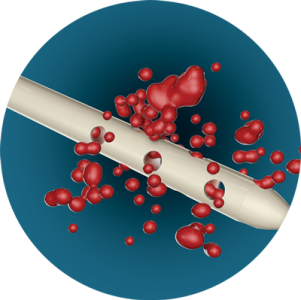
Aspiration
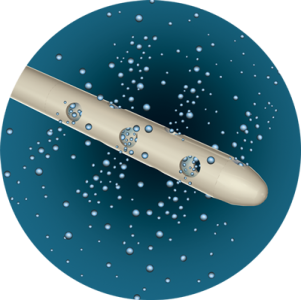
Irrigation
Integrated, Continuous ICP Monitoring
Elevated intracranial pressure (ICP) is a common cause of neurological damage and death in patients with any neurosurgical disorder. Continuous ICP monitoring has been clinically proven in studies since 2012 to decrease patient mortality rates.1 Given this, it is vital that you have a product that not only has continuous monitoring, but also has a drainage catheter that remains unobstructed during the procedure.
IRRAflow provides these attributes by combining drainage, irrigation, and pressure monitoring into one easy-to-use integrated fluid management system. This innovative, new monitoring system automates pressure data collection, allows for custom alarms when pressure rises, and actively manages ICP through its proprietary fluid exchange technology.
- 5. Yuan Q, Wu X, Sun Y, et al. Impact of intracranial pressure monitoring on mortality in patients with traumatic brain injury: a systematic review and meta-analysis. J Neurosurg. 2015;122:574–87.
Potential to Reduce Occlusions & Infections
The evolution of EVD technology has been limited, so neurosurgeons and ICU staff still deal with catheter occlusion rates up to 40%1 as well as infection rates that can range from 2 – 24%.2 At IRRAS, we believe that it is time for a needed step forward in fluid management technology that addresses these clinical challenges and improves outcomes.
IRRAflow’s innovative closed system design responds to these issues with its use of a proprietary dual-lumen catheter and automated software to drain excess fluid in a controlled fashion. IRRAflow’s dual lumen catheter was designed to enable active fluid exchange by enabling irrigation with physiologic fluids and drainage of pathological material. IRRAflow‘s Active Fluid Exchange mechanically cleanses the catheters tip thus potentially facilitating disruption of clot and or bacteria.3,4
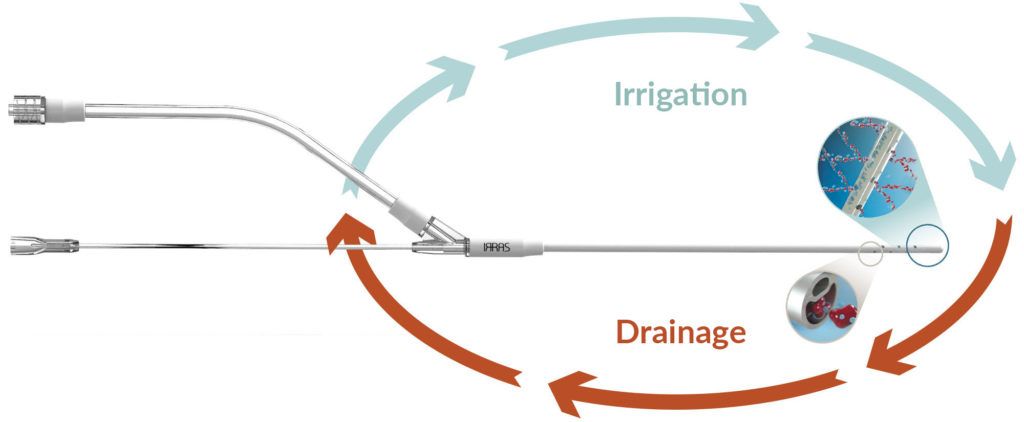
- 6. Fargen KM, Hoh BL, Neal D, O’Connor T, Rivera-Zengotita M, Murad GJ. The burden and risk factors of ventriculostomy occlusion in a high-volume cerebrovascular practice: results of an ongoing prospective database. Journal of Neurosurgery. 2015:1-8.
- 7. Citerio G, Signorini L, Bronco A, Vargiolu A, Rota M, Latronico N. External Ventricular and Lumbar Drain Device Infections in ICU Patients: A Prospective Multicenter Italian Study. Crit Care Med. 2015 Aug;43(8):1630-7.
- 8. Rajjoub K, Hess R M, O’Connor T E, et al. (May 22, 2021) Drainage, Irrigation, and Fibrinolytic Therapy (DRIFT) for Adult Intraventricular Hemorrhage Using IRRAflow® Self-Irrigating Catheter. Cureus 13(5): e15167. DOI 10.7759/cureus.15167
- 9. Brandmeir, Nicholas, et.al. Early Experience with Patient Treatment & Drug Delivery with IRRAflow; An Automatically Irrigating and Draining Ventricular Catheter. As presented at The Neurosurgical Society of the Virginias Annual Meeting in January 2022.
- 10. Rezai Jahromi, Behnam. Active CSF Exchange for Removal of SAH to Reduce Shunt Dependency. As presented at the Congress of Neurological Surgeons, 2022, San Francisco, CA.
- 11. Rezai Jahromi, Behnam. Active CSF Exchange is for IVH Treatment. As presented at the European Association of Neurological Societies, 2022, Belgrade, Serbia.
